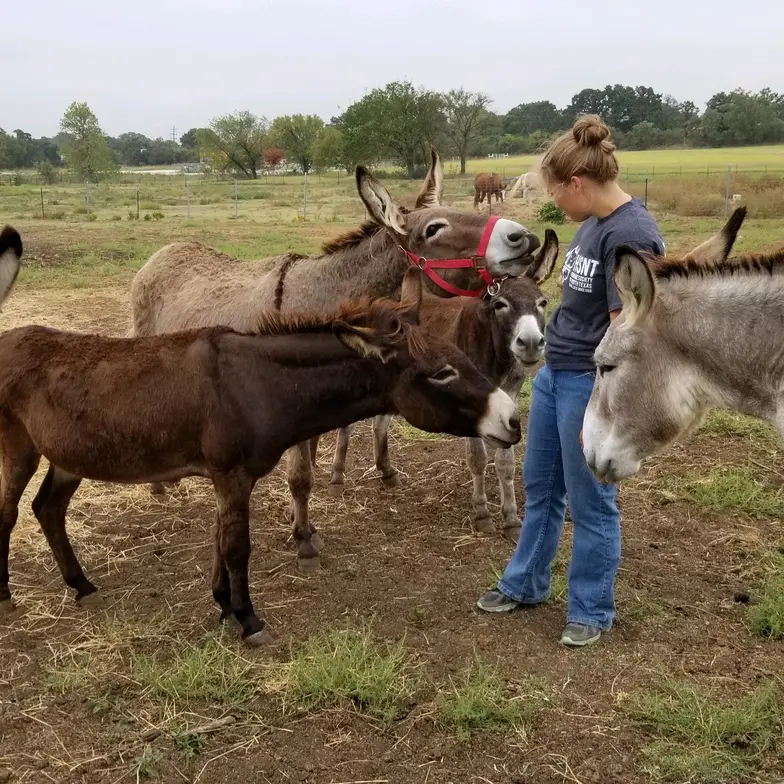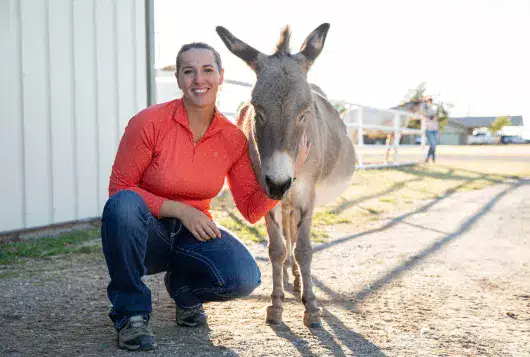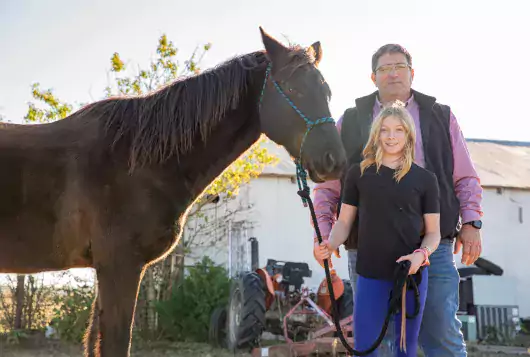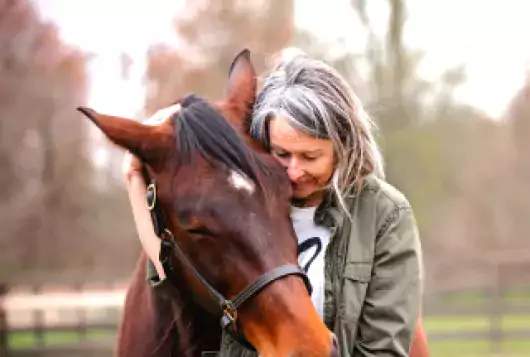6 Tips for Getting Donkeys Adopted

In just two years, the Humane Society of North Texas (HSNT) in Joshua, TX, found homes for 78 donkeys! During that time, they've learned plenty about successfully adopting out long-eared equines. Read on to learn five donkey-homing strategies from Heidi Garbe, HSNT's director of equine and livestock.
- Provide Training
"We love training the donkeys the same as the horses—minus the riding, usually," Garbe says. HSNT expects their donkeys to be able to be haltered, led, groomed, load onto a trailer, and have their feet picked up. These simple things make the donkeys easier to adopt out. If they don't have the basics down, HSNT creates training plans so that all staff members are on the same page with training goals. Garbe says they do target training, which can help them manage any animal. Trick training is a strategy they use based on individual personalities, especially when an equine needs a boost to get adoption attention. Most importantly, Garbe suggests, "Have fun with the donkeys—they are such amazing equines, and once you understand their motivations and tendencies, you can work through just about anything!"
- Make Good Matches
Garbe says the most important matchmaking tip is to "figure out what each person wants and what each donkey needs." Some people want donkeys on their property for tax reasons or protection and aren't interested in a specific animal. Others want a family pet, gentle enough for their kids. HSNT strives to make each animal social and handleable before they get adopted, but if they are not progressing in their training, Garbe notes that cattle ranches with the capacity to work animals in pens can help ensure welfare for the donkey. "Bottom line, before adopting, we want each potential adopter to spend time with the animals and share why they want a donkey. That knowledge, their hands-on abilities with the animals, and their home facilities help us determine if we have a good match," she says.
- Employ Clever Marketing Techniques
HSNT uses a variety of techniques to market their donkeys, including:
- Focus on each animal's story, whatever it might be, and then on the strengths of the animal (this one loves to be touched, this one knows how to lead, this one can pick up all his feet, this one would probably make a good protector of livestock – or not).
- Promote donkeys as companions for horses.
- Adopt out donkeys in pairs (or more)! Garbe says, "We had one very nice rancher who wanted four donkeys and was willing to take the ones who were the most unhandled; I put five donkeys in the catch pen the day he came to look at them, just in case, and he took all five!"
- Try a donkey-themed event! "Recently we had over 50 donkeys arrive at one time along with an influx of horses, so we did a series of open houses patterned after famous horse races. We titled one "Preakness Stakes Donkey Edition," which was promoted through news outlets and resulted in a huge response," says Garbe.
- Inform Owners
While they are adorable and may seem more self-sufficient than horses, donkeys need to be managed and cared for much in the same ways as horses. And there are at least 10 ways donkeys are different than horses. Garbe says it's important to talk to adopters about the following:
- Hoof care
- Metabolic concerns
- Teeth
- Deworming
- Vaccinations
- Fly management
- Human and donkey safety
Garbe says they work with adopters in the pen to show them how to stay safe and build a relationship with "these heavy-thinking equines” in order to prevent scenarios such as “finding ourselves 10 years down the road with someone saying, 'I have a 15-year-old donkey who is wild living on 10 acres, but I'm moving and I don't know what to do – can you help?'" HSNT avoids these situations by setting the donkeys and people up for success.
- Partner with Donkey Experts
Connecting with local experienced donkey enthusiasts for guidance is another great way to help place donkeys. "We met several people through our adoption appointments who gave us ideas and feedback to help advance our work with our donkeys—from feeding ideas to grooming suggestions to troubleshooting behavior issues. By sharing experiences, we were all able to help each other," Garbe says.
- Be Prepared
If your organization anticipates taking in unsocialized donkeys, Garbe recommends a small catch pen with a squeeze chute to ensure care and safety for the donkeys and handlers when up-close work is required. HSNT often utilizes a modified stall system with four moveable fence panels, which allows them to keep the donkey in a small space while they halter the animal or perform medical care. To avoid injury, Garbe warns that restraint pens should be used with caution by someone with experience and that some donkeys can also clear five-foot fences, so plenty of space and catch areas are essential. Other safety precautions HSNT uses are solid, five-foot no-climb fencing for most of their pastures and breakaway halters or neck collars, which help identify individuals in big groups.
We have lots more on this subject:



